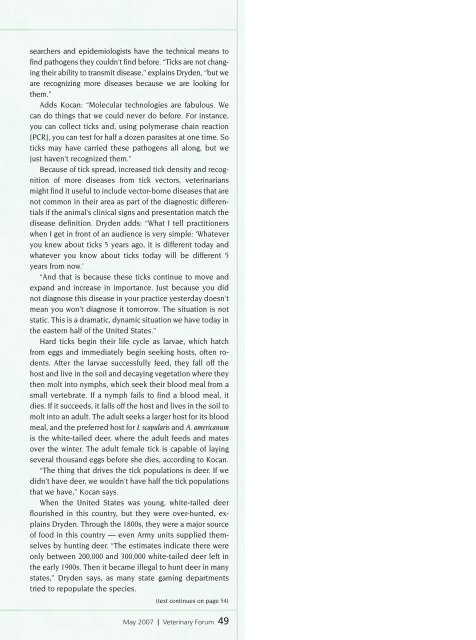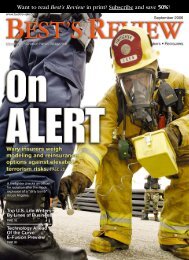Selected US Ticks and Tick-borne Pathogens - tabpi
Selected US Ticks and Tick-borne Pathogens - tabpi
Selected US Ticks and Tick-borne Pathogens - tabpi
You also want an ePaper? Increase the reach of your titles
YUMPU automatically turns print PDFs into web optimized ePapers that Google loves.
searchers <strong>and</strong> epidemiologists have the technical means to<br />
find pathogens they couldn’t find before. “<strong><strong>Tick</strong>s</strong> are not changing<br />
their ability to transmit disease,” explains Dryden, “but we<br />
are recognizing more diseases because we are looking for<br />
them.”<br />
Adds Kocan: “Molecular technologies are fabulous. We<br />
can do things that we could never do before. For instance,<br />
you can collect ticks <strong>and</strong>, using polymerase chain reaction<br />
[PCR], you can test for half a dozen parasites at one time. So<br />
ticks may have carried these pathogens all along, but we<br />
just haven’t recognized them.”<br />
Because of tick spread, increased tick density <strong>and</strong> recognition<br />
of more diseases from tick vectors, veterinarians<br />
might find it useful to include vector-<strong>borne</strong> diseases that are<br />
not common in their area as part of the diagnostic differentials<br />
if the animal’s clinical signs <strong>and</strong> presentation match the<br />
disease definition. Dryden adds: “What I tell practitioners<br />
when I get in front of an audience is very simple: ‘Whatever<br />
you knew about ticks 5 years ago, it is different today <strong>and</strong><br />
whatever you know about ticks today will be different 5<br />
years from now.’<br />
“And that is because these ticks continue to move <strong>and</strong><br />
exp<strong>and</strong> <strong>and</strong> increase in importance. Just because you did<br />
not diagnose this disease in your practice yesterday doesn’t<br />
mean you won’t diagnose it tomorrow. The situation is not<br />
static. This is a dramatic, dynamic situation we have today in<br />
the eastern half of the United States.”<br />
Hard ticks begin their life cycle as larvae, which hatch<br />
from eggs <strong>and</strong> immediately begin seeking hosts, often rodents.<br />
After the larvae successfully feed, they fall off the<br />
host <strong>and</strong> live in the soil <strong>and</strong> decaying vegetation where they<br />
then molt into nymphs, which seek their blood meal from a<br />
small vertebrate. If a nymph fails to find a blood meal, it<br />
dies. If it succeeds, it falls off the host <strong>and</strong> lives in the soil to<br />
molt into an adult. The adult seeks a larger host for its blood<br />
meal, <strong>and</strong> the preferred host for I. scapularis <strong>and</strong> A. americanum<br />
is the white-tailed deer, where the adult feeds <strong>and</strong> mates<br />
over the winter. The adult female tick is capable of laying<br />
several thous<strong>and</strong> eggs before she dies, according to Kocan.<br />
“The thing that drives the tick populations is deer. If we<br />
didn’t have deer, we wouldn’t have half the tick populations<br />
that we have,” Kocan says.<br />
When the United States was young, white-tailed deer<br />
flourished in this country, but they were over-hunted, explains<br />
Dryden. Through the 1800s, they were a major source<br />
of food in this country — even Army units supplied themselves<br />
by hunting deer. “The estimates indicate there were<br />
only between 200,000 <strong>and</strong> 300,000 white-tailed deer left in<br />
the early 1900s. Then it became illegal to hunt deer in many<br />
states,” Dryden says, as many state gaming departments<br />
tried to repopulate the species.<br />
(text continues on page 54)<br />
May 2007 | Veterinary Forum 49













